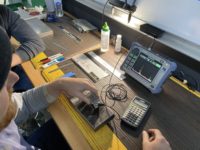
Last fall, after months of gathering information, the board investigating the Columbia shuttle disaster had pinpointed its cause and released a series of recommendations, including the increased use of nondestructive testing (NDT) and the development of new NDT technologies. Since then, there have been significant changes in NASA's space shuttle return-to-flight effort, the latest of which are detailed in the second interim report issued by the Stafford-Covey Task Group in May.
The return-to-flight task group conditionally closed out three Columbia Accident Investigation Board (CAIB) recommendations. One of the CAIB recommendations being closed out regards reinforced carbon-carbon (RCC) NDT inspection. CAIB recommended that NASA "develop and implement a comprehensive inspection plan to determine the structural integrity of all RCC system components. This inspection plan should take advantage of advanced nondestructive inspection technology."
Excellent progress has been made in the development and implementation of an inspection plan for all RCC, according to the task group report. NASA has selected three NDT technologies for on-vehicle RCC inspection between missions: thermography, X-ray and eddy current. These technologies will be developed and fielded at Kennedy Space Center for use before the second flight of each vehicle and before all flights thereafter. The data produced will complement and enhance the protection against abnormal flight and processing damage offered by current visual and tactile inspections.
The manufacturer has rebaselined all RCC components for the Discovery and Atlantis Space Shuttles, and thermography has been completed at Kennedy Space Center. In the process of rebaselining, the original oxidation life reduction curves have been validated and the established schedules for refurbishing and replacing RCC panels and attach hardware have also been verified. No significant accumulated impact damage has been discovered in any RCC components, and no corrosion issues were found through examination of attachment hardware.
The manufacturer found a few minor voids that were introduced during manufacturing but went undocumented in the original acceptance screening. Some of these voids were analyzed in detail and found acceptable; others remain to be analyzed.
After components are NDT inspected at the vendor and shipped to Kennedy Space Center, thermography is used to establish a baseline and compare to original NDT inspection acceptance criteria. NASA's plan is to correlate the thermography data to the vendor NDT inspection data and other sensor data.
To help develop these technologies, NASA is establishing a server-based RCC NDT inspection database for easy retrieval of stored data as well as developing a Data Fusion visualization tool to accommodate the overlay of RCC NDT inspection data onto a Catia CAD model. This will enable visualization of NDT features using the structure CAD model, comparison of new NDT data with baseline data to evaluate changes in hardware condition, streamlining of data evaluation for Problem Report/Material Review disposition, and remote access to NDT data via the NDT database server.
There has been substantial progress on virtually all of the remaining return-to-flight recommendations, the task group reports. It is anticipated that several more recommendations will be substantially met by the next task group plenary session this summer.
Analytical and testing techniques will allow a level of comfort before launch, and advances in NDT techniques may add to confidence. However, statistically significant results verifying external tank debris conditions may not be accomplished, even by the end of the Shuttle Program.
As such, on-orbit inspection and repair remain necessary to reduce the risk to future flights. Should one or both of these capabilities not be fully developed by the anticipated date of return to flight, the ability of the crew to await a rescue mission at the International Space Station (ISS) will become an important consideration for the next launch.
